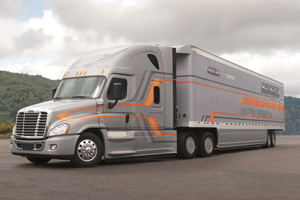Daimler Says New Cascadia Tops 9 MPG in Road Trials

This story appears in the June 4 print edition of Transport Topics.
OXON HILL, Md. — Daimler Trucks North America unveiled what will become its primary over-the-road heavy-duty tractor next year and said the new model — named the Cascadia Evolution — will be about 7% more fuel-efficient than its 2010 model.
A test version of the 2014 model, which will go into production in the first quarter of next year, averaged 9.3 miles per gallon as it recently hauled a fully loaded test trailer from California to North Carolina, company officials said.
Unveiling the truck at a May 30 press conference here, Mark Lampert, DTNA’s senior vice president for sales and marketing, said the Evolution “is the embodiment of our continuing commitment to customers to provide them with a competitive advantage in the marketplace.”
Daimler hosted Transportation Secretary Ray LaHood at the meeting in the Washington suburbs, and he spoke about manufacturing jobs, alternative-fuel vehicles and highway funding after looking at an assortment of DTNA trucks with company executives.
DTNA CEO Martin Daum said Freightliner is now within striking distance of the 10-mpg goal that he set in a March 2010 speech. Combining the aerodynamic improvements on the tractor with a new version of the Detroit DD15 engine and transmission, the truck got 9.3 mpg on the cross-country highway test.
Company officials said that the truck-trailer combination hit nearly 10.7 mpg on a test track during another test.
The new model will cost more than the current version, but Lampert said final pricing has not been set.
He did say the fuel-economy improvements should pay for the extra up-front costs within 18 months, or “shorter than any trade cycle.”
Daum said the efficiency gains in the Evolution derived equally from aerodynamic improvements and from mechanical gains, primarily in the new engine.
Getting the test truck to 9.3 mpg was the result of many small, useful changes rather than a single extraordinary development, the DTNA executives said. The engine has a new asymmetric turbocharger and a water pump that uses less power. It is fed by a common-rail fuel system with more pressure than current models.
Mirrors and the windshield were reshaped, and fairings and extenders were added to the tractor and trailer for better aerodynamic flow. Care also was given to the selection of axles, transmission, wide-based tires and other components and systems.
The actual performance of the truck will vary based on how and where it is used, officials said. And the trailer used in the test is a one-of-a-kind model that combines many of the latest features offered by several competing manufacturers.
Daum urged fleets to focus on scientific versus market testing, meaning serious engineering reports, as compared with boasts from marketing departments.
Driving from California to North Carolina, engineers noted the largest mileage improvement between Albuquerque, N.M., and Oklahoma City, when the truck had to fight persistent, high crosswinds.
Daimler also recently ran a natural gas tour from California to Washington, D.C., using a day cab powered by a 12-liter Cummins-Westport natural gas engine running on compressed natural gas. The driver bought CNG only from public fueling stations and was able to make it across the country.
At the event last week, DTNA displayed several heavy- and medium-duty Freightliners that run on natural gas or propane.
Looking at the North American truck market, Daum said he still thinks sales of Classes 6-8 vehicles will continue to increase this year over the 2011 results, despite bad economic news from Europe and, to a lesser degree, from China.
He described the North American truck market as a “roller coaster,” hitting a record in 2006 before descending into “the worst crisis ever” in 2009. 2012 is close to normal by historic standards, he said, with 375,000 vehicles a year as typical.
“We’re expecting 360,000 to 370,000 this year,” Daum said. After four months, he said, Canadian Class 8 sales are expanding by about 14%, year-over-year, and U.S. sales by more than 11%. Heavy-duty sales in Mexico, however, contracted by nearly 2%.




